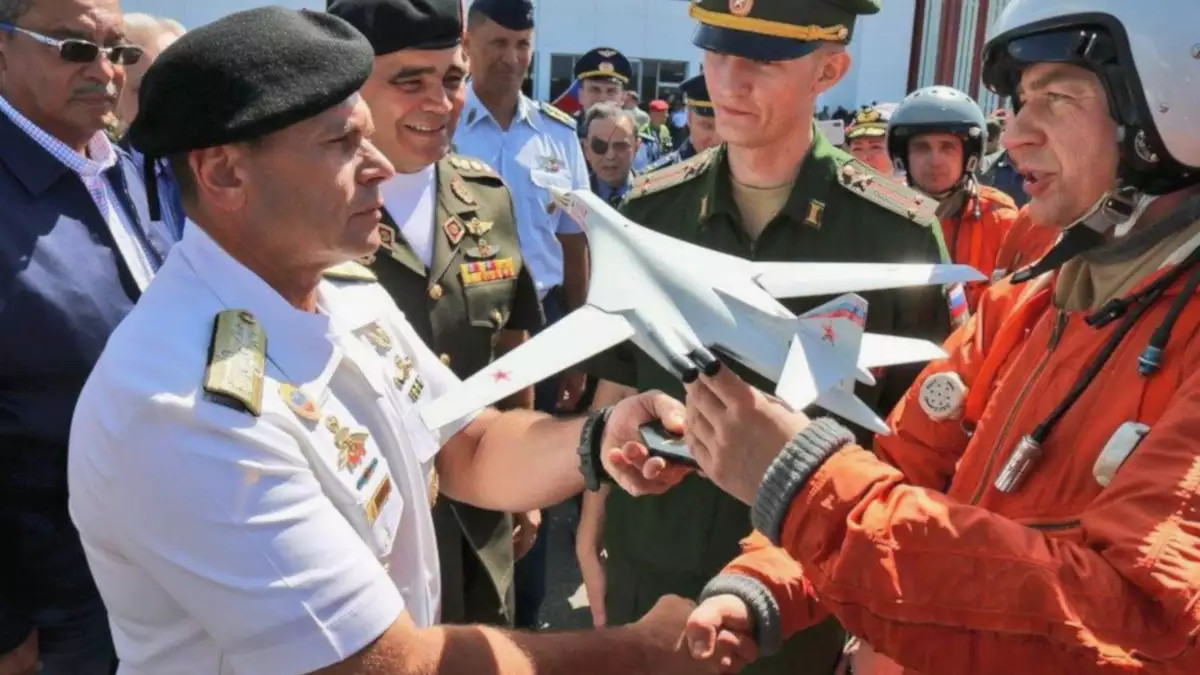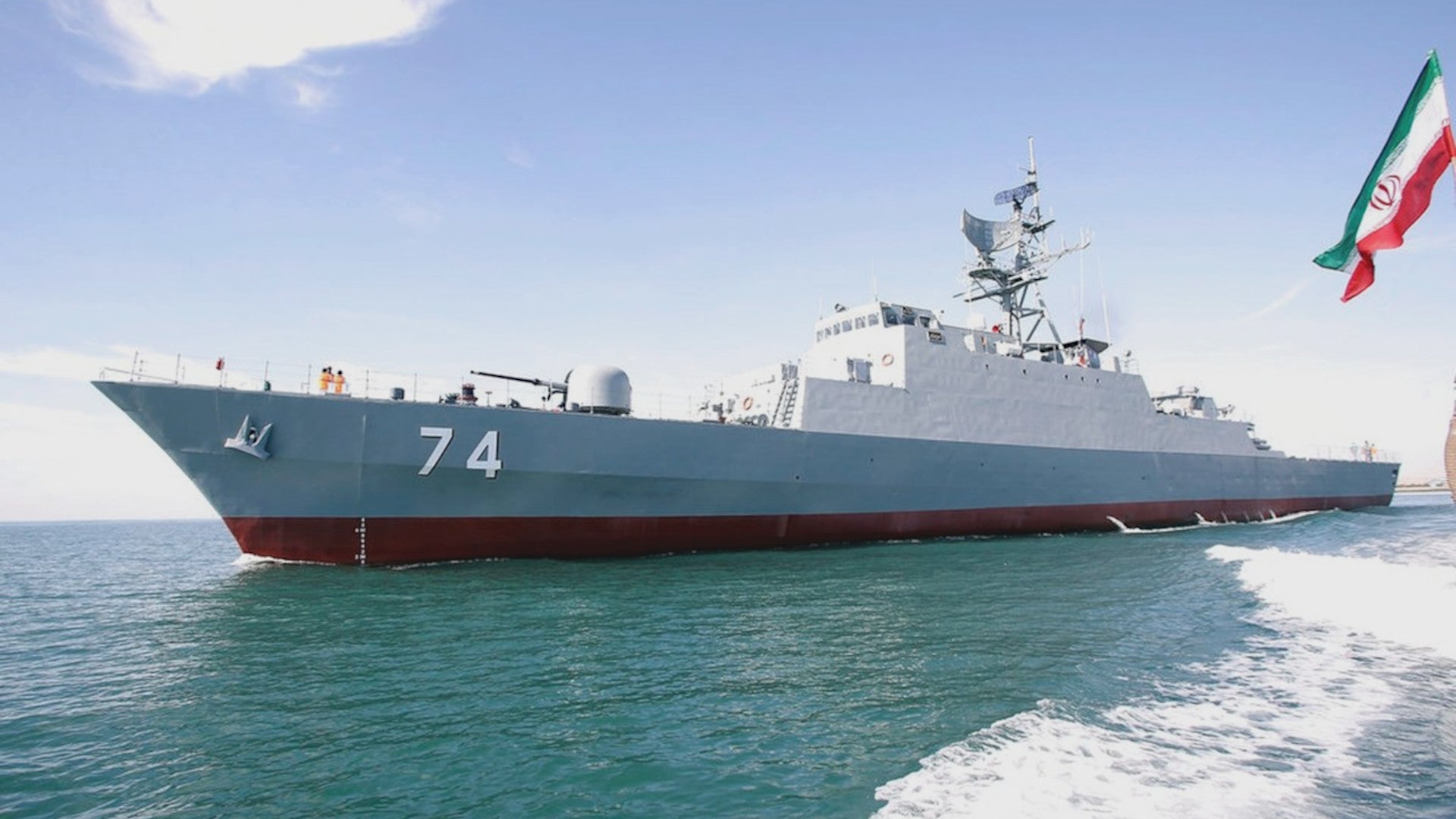Iran has claimed it will send a naval flotilla, which may include its newest corvette, the Sahand, into the Atlantic Ocean and possibly to Venezuela in the coming months. But the Iranians, who regularly object to the presence of American warships near their territorial waters in the Persian Gulf, have been suggesting they could make a similar show of force near the United State for nearly a decade and has never followed through. The Iranian Navy doesn’t look to be in any better a position to carry out this mission than it has in the past.
Iranian Navy Admiral Touraj Hasnai Moqaddam, the service’s deputy commander, stated the plans on Jan. 4, 2019, the state-run Islamic Republic News Agency, or IRNA, reported. It is unclear whether Moqaddam’s comments were new, though, as he had made virtually identical remarks at the commissioning ceremony for Sahand on Dec. 1, 2018.
“The Atlantic Ocean is a long route, and it is likely that this Iranian mission would take five months to complete,” he said, according to IRNA.
“Among our plans in the near future is to send two or three vessels with special helicopters to Venezuela in South America on a mission that could last five months,” the senior Iranian naval officer had told the semi-official Mehr news agency in December 2018.

It seems likely that Sahand, which carries the same name as an earlier corvette the U.S. Navy sank during a skirmish in 1988, would be among those ships. Iranian authorities tout it as not only the most advanced warship in their country’s navy, but the most capable one anywhere in southwest Asia. This is, at best, debatable given what is known about the ship’s features as compared to larger warships in service in the region in countries such as Saudi Arabia and the United Arab Emirates.
By every indication, this is unsupported bluster. Iran describes the Sahand as a destroyer, despite the fact that it displaces around 2,000 tons, making it a corvette by any reasonable definition.
Iran also claims that it is an entirely Iranian design, but it appears to be derived from the earlier Moudge-class, which was itself reverse-engineered from the British-made Alvand-class that the Islamic Republic inherited from the previous imperial regime. In addition to Sahand, Iran has three Alvands and a single example of the Moudge-class in service. A second Moudge-class ship, the Damavand, sank in the land-locked Caspian Sea after running aground in December 2018.

Like the earlier Moudge-class ships, Sahand has a helipad, but no hangar to shield a helicopter on board from the elements during sustained operations. There is nothing about the ship’s design to support the claims that it has any stealthy features.
The Sahand’s armament includes Qader sub-sonic anti-ship missiles, derivatives of the Chinese C-803, as well as Sayyad-2 surface-to-air missiles, a reverse-engineered version of the U.S. RIM-66 Standard Missile-1 (SM-1). They also have a 76mm main gun, a close-in self-protection system, torpedo tubes, and various smaller automatic cannon and machine guns.
That’s not to say that Iran’s desire to deploy some type of naval vessel into the Atlantic and to have them make a visit to Venezuela isn’t real or doesn’t make sense. In December 2018, the U.S. Navy aircraft carrier USS John C. Stennis and her associated strike group sailed into the Persian Gulf.

There had not been an American flattop in that body of water since March 2018, an unprecedented gap period after years of rotational deployments to the region support various conflicts in the Middle East and Afghanistan. Though the ship and its air wing are now supporting the fight against ISIS in Iraq and Syria, the future of which is now uncertain, the move also appeared to be a signal to Iran.
In November 2018, President Donald Trump’s administration had put a raft of sanctions against Iran back into place, a product of the United States’ decision to pull out of the multi-national deal over Iran’s controversial nuclear program. Iranian and U.S. officials had traded various threats and other inflammatory rhetoric throughout 2018.
U.S. relations with Venezuela are also strained at present over the policies of its increasingly dictatorial president Nicolás Maduro. An Iranian military visit to the country to show support for Maduro’s regime would be sure to incite the ire of officials in Washington. The United States vocally criticized Russia’s deployment of Tu-160 bombers and supporting aircraft and personnel to the Latin American country in December 2018.

But Iran has long decried the presence of the U.S. military in the Persian Gulf and since 2011 has claimed it is preparing to conduct similar naval patrols near the United States. None of those pronouncements has actually led to Iranian warships operating in the Atlantic at all, let alone close to American or Venezuelan shores.
Despite Admiral Moqaddam’s claims, the Iranian Navy simply lacks the logistical capacity to project power globally. The Alvands have a maximum range under ideal conditions of around 4,500 miles. It is not clear how much additional range the Sahand, a derivative design, might have, if any.
Iranian officials have discussed the possibility of establishing bases in friendly countries in the Middle East, but have yet to do so. The country also lacks a true at-sea replenishment capability, though it has deployed the Kharg, a modified fleet tanker, to support previous deployments into the Gulf of Aden and the Indian Ocean. Iran insists on calling the Kharg a “helicopter carrier,” but it is no such thing.
Even if the Iranian flotilla made its way out into the North Atlantic via the Mediterranean Sea, there is no guarantee it would be able to make it across the Pond. The shortest distance between West Africa and Venezuela is around 3,000 miles, which leaves little room for bad weather or other problems that could slow up the ships and threaten to leave them stranded in the middle of the ocean without fuel.

A more circuitous route that takes the ships further down the African coastline and then a much shorter distance across to Brazil might be feasible, but could also run the risk of political difficulties. Brazil’s new hardline, right-wing President Jair Bolsonaro is seeking closer ties with the United States, has previously criticized Iran, and opposes Venezuela’s present regime.
As such, he might seek to block Iranian warships from entering Brazilian ports. Any other country that does not have overtly friendly relations with Iran might also be wary of letting the flotilla in.
Russia found itself in a similar predicament in 2016, when Spain refused to allow the aircraft carrier Admiral Kuznetsov
into port to refuel under heavy international pressure. The flattop and its aircraft were on their way to Syria and the ship subsequently had to wait for tankers to arrive to refuel it at sea before it could continue with its deployment. The entire episode was extremely embarrassing for the Kremlin.
Similar logistical considerations likely forced Iran to scrap another planned naval deployment into the Atlantic in 2014. The Alvand-class Sabalan and the Kharg only appear to have gotten as far as the Gulf of Aden, where they conducted counter-piracy missions, before returning home.
As we at The War Zone have noted before, Iran poses a real threat to U.S. naval activities and commercial maritime traffic in the Persian Gulf, and the strategic Strait of Hormuz, in particular. Via its proxies, it has been able to extend some of those capabilities regionally, as well. This is to say nothing of its non-naval capabilities, including its growing arsenal of ballistic missiles, and expansive ties to militant and terrorist groups.
Its ability to project naval power outside of the Middle East, however, is virtually non-existent at present. Even if Iran does finally manage to send ships into the Atlantic after all these years, it would be such a small deployment requiring immense effort and resources that it would not reflect a real military capability. Whether or not officials in Iran decide it’s still worth it for the potential propaganda value remains to be seen.
There are legitimate reasons to criticize Iran’s foreign policy and its interventions in various conflicts, especially in Syria and Yemen. But any concerns about Iranian warships heading into the Atlantic and possibly toward the American coast – events that seem as unlikely as ever to occur at all – are decidedly overblown.
Contact the author: joe@thedrive.com
